Testing an upstream path of a cable network
- Summary
- Abstract
- Description
- Claims
- Application Information
AI Technical Summary
Benefits of technology
Problems solved by technology
Method used
Image
Examples
Embodiment Construction
[0053]While the present teachings are described in conjunction with various embodiments and examples, it is not intended that the present teachings be limited to such embodiments. On the contrary, the present teachings encompass various alternatives, modifications and equivalents, as will be appreciated by those of skill in the art.
[0054]Referring to FIG. 1, a cable network 100 includes a headend 101, a plurality of nodes 102, and a plurality of terminal devices 104. A cable plant 106 connects the terminal devices 104 to the respective nodes 102, and the nodes 102 to the headend 101. The terminal devices 104 can include digital TV boxes, VoIP phone systems, and cable modems. In operation, the headend sends downstream signals 108 to the terminal devices 104 through the cable plant 106. The downstream signals 110 include TV broadcasting signals, as well as DOCSIS downstream data packets and control signals. The terminal devices 104 send upstream signals 110, for example DOCSIS upstrea...
PUM
 Login to View More
Login to View More Abstract
Description
Claims
Application Information
 Login to View More
Login to View More - R&D
- Intellectual Property
- Life Sciences
- Materials
- Tech Scout
- Unparalleled Data Quality
- Higher Quality Content
- 60% Fewer Hallucinations
Browse by: Latest US Patents, China's latest patents, Technical Efficacy Thesaurus, Application Domain, Technology Topic, Popular Technical Reports.
© 2025 PatSnap. All rights reserved.Legal|Privacy policy|Modern Slavery Act Transparency Statement|Sitemap|About US| Contact US: help@patsnap.com



